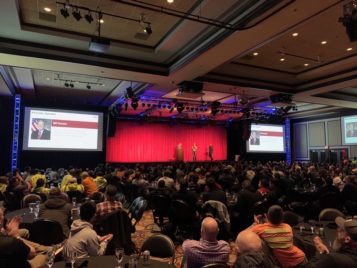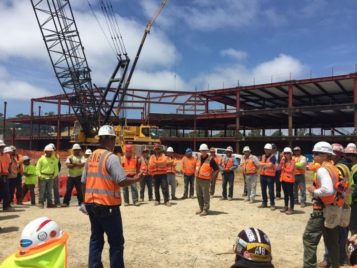
Planning, training to minimize risk
By Dwayne Goddard
As a senior superintendent, I have been working in the construction industry for more than 42 years. I have seen the industry evolve, particularly in the way we approach unknowns on a jobsite. Gone are the days of walking on a new site and immediately digging a trench or tearing down walls. Now more than ever, the emphasis is on planning and identifying potential hazards before they occur.
Plan the work, work the plan
In my career working for multiple general contractors, I have observed a drastic variation in the frequency that contractors encounter surprises onsite. Companies that spend time to properly investigate and plan in advance are able to substantially minimize unexpected encounters with underground utilities or other unknowns.
Unknown site conditions
Early site investigations may indicate areas of concern. For a recent project, the Tukwila Justice Center in Tukwila, Washington, we learned early on that we would likely encounter environmental contamination from previous industrial and auto-oriented uses. Using the owner’s boring information and working with the owner’s third-party consultant, we mapped out the areas of concern and excavated these areas early to help mitigate potential schedule delays. It was crucial to secure unit pricing and a location for disposing of the contaminated material before encountering it, to keeping the project on schedule and reduce standby time costs to the owner.
Existing utilities
When dealing with existing utilities, our first step is to make and maintain color-coded master utility site maps used by all trades and workers onsite. Our goal is to understand where the main utility feeds enter the site, where they enter structures and their path of travel. We also identify meters, shut-off valves and vaults; and we camera-scope existing storm and sewer lines to be re-used. To create these utility maps, team leaders can call 811 for utilities to be located or utilize a private locate company. Additionally, as-built drawings, topographic surveys, ground penetrating radar, laser scanning, potholing, communication with utility companies and a visual inspection of the buildings and site help create these master, color-coded maps.
Prior to beginning work, fill out any applications to have utilities disconnected by the utility service provider and review the safe digging practices for your region. For utilities that are to remain, provide protection for the lines, create a separate plan for working around those utilities and install signage where utilities are located.
As structures are demoed and existing utilities are cut back to the property line or to the street, it’s important to update utility maps by removing demoed utilities. Any lines remaining onsite can be integrated into your BIM models, and any new lines installed should be added to the utility maps.
Demolition
During full building and site demo, our best practice is to employ tradesmen that are trained in the utility being removed. For example, electrical tradesmen are most appropriate to cut, cap and remove electric panels, rather than general demo crews. Once the disconnects are all saved off, the buildings can be turned over to the demo contractor to demolish and the site can be turned over to the excavation/utility company for utility removal.
When buildings are to remain and demo is involved, it is best to start by removing one side of the walls/ceilings and have electricians, HVAC companies and fire protection professionals remove work associated with their trades one piece at a time. They are most qualified to inspect, gather information and disconnect. Once these steps are completed, demolition can begin.
Sharing the knowledge
Even with the best plan and information gathering, the unexpected can still happen. Sometimes the locates are wrong or the as-built drawings are incomplete. I have learned that training is the most important factor that affects positive, safe outcomes when dealing with underground utilities and unknowns onsite. Incidents and near misses should not become an opportunity to blame. Senior leaders should use those incidents to mentor and train the younger team members about safety and quality control, and pass on their knowledge earned from years on a jobsite.
For example, our project teams regularly participate in:
- Companywide monthly safety breakfasts, which cover pertinent topics. A recent focus was ground penetration, allowing an opportunity for all to be trained on how to minimize unknowns when starting to dig onsite.
- Two training meetings per month where the superintendents train other superintendents and foremen on safety, quality control and best practices.
- Monthly superintendent mentoring session group training.
- Monthly foreman mentoring group training.
- Weekly safety coordination meeting for projects that had an incident that week. This provides an opportunity to identify and resolve any patterns that may be leading to other injuries, property damage and near-misses.
- Monthly call to go through all the incidents for the month. All teams companywide call in and use this information to help prevent the same type of incidents on their projects.
- Annual safety summit.
Onsite safety
Once the planning is done, the work begins and the crews need to execute the plan. Each day this starts with a morning safety huddle followed by stretch and flex. Also, before work starts, pre-task plans need to be completed by each crew and any permits (dig, burn, coring) need to be signed off. We have also implemented a coring permit as a new best practice for coring any concrete work to help mitigate any structural issues, and the use of stair ladders (versus stairs) to help prevent ladder accidents.
As superintendents, our job is about leadership, logistics, coordination and leading multiple teams to safely execute a plan. We help keep harmony on the jobsite and we help keep everyone safe. While we cannot eliminate every hazard, we can minimize unknowns that originate from the jobsite. We cannot remove all risk; but we can curtail threats and use our intelligence and experience to help ensure everyone stays safe, and help assure that even the most dramatic onsite surprises lead to positive outcomes.
Dwayne Goddard is a senior superintendent with BNBuilders.
Photos courtesy of BNBuilders.




 Join our thriving community of 70,000+ superintendents and trade professionals on LinkedIn!
Join our thriving community of 70,000+ superintendents and trade professionals on LinkedIn! Search our job board for your next opportunity, or post an opening within your company.
Search our job board for your next opportunity, or post an opening within your company. Subscribe to our monthly
Construction Superintendent eNewsletter and stay current.
Subscribe to our monthly
Construction Superintendent eNewsletter and stay current.